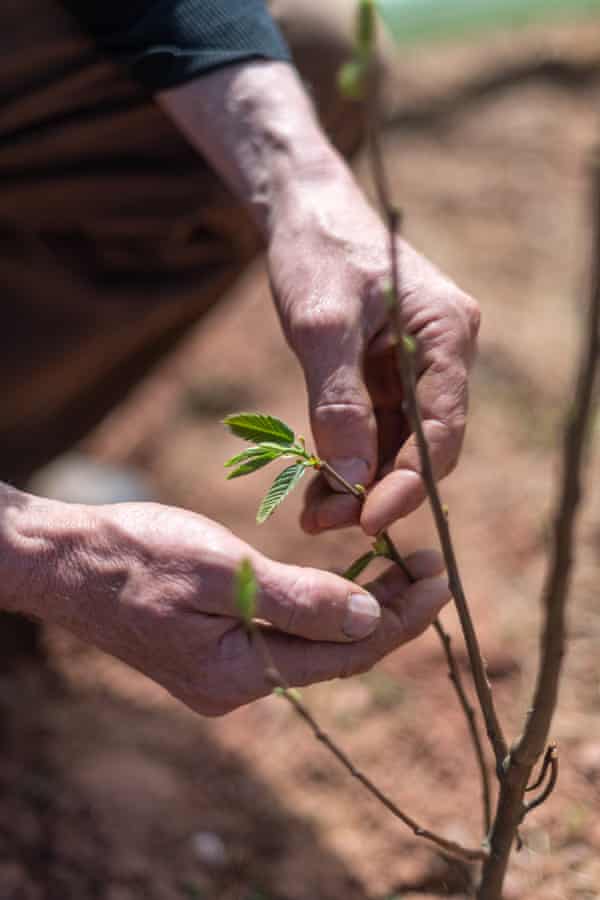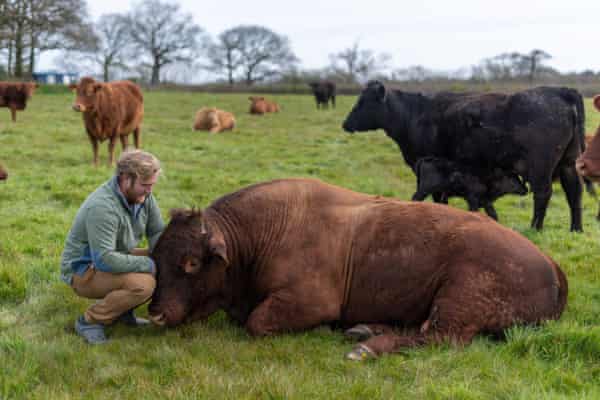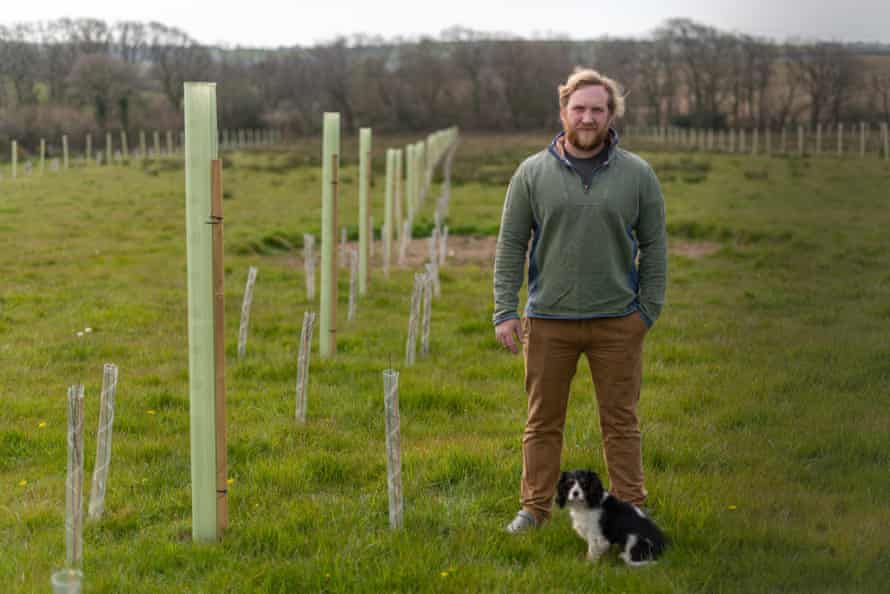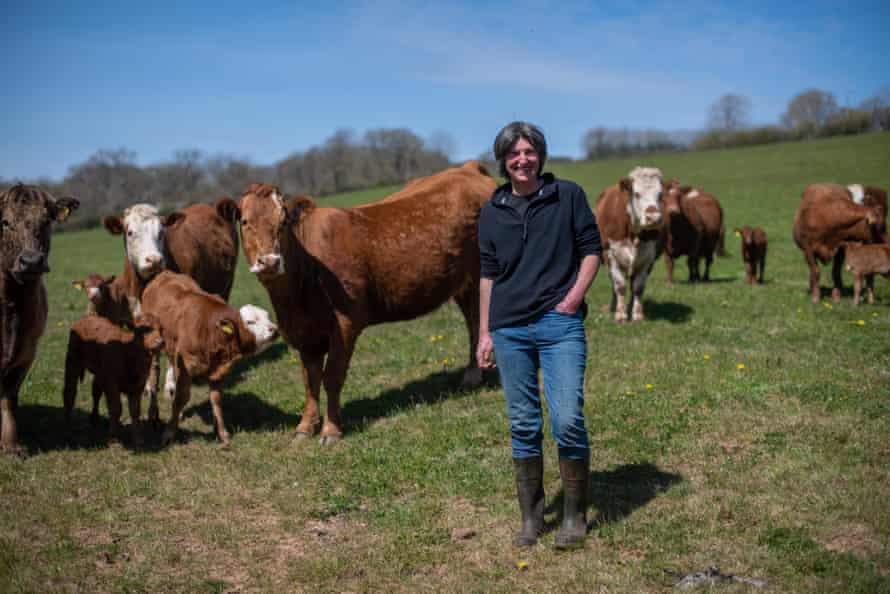Andy Gray stands beside an enormous hill of bare red earth and smiles with a hint of mischief. This is his best field, its soils known as Crediton red land. The region was once known for producing swedes prized by Covent Garden market. Now, every six metres, planted in rows 14 metres apart, stands a tree guard shielding a young oak, aspen or alder.
“You can grow anything on it and I’m planting trees,” says Gray, a 16th-generation Devon farmer. “I’m seen as the fool on the hill. One neighbour said ‘you might as well concrete it over and build houses’. They could be right. Who knows?”

Gray’s radical change of direction is not tree-hugging environmentalism but a hardheaded commercial calculation. It’s also born out of curiosity. He wants to know how trees might benefit his soil and livestock. By planting 5,600 trees on his 165-acre farm, he is participating in a unique 12-year trial to test how well silvopasture – farming livestock with trees – improves the environment and increases productivity.
Studies outside Britain suggest silvopasture’s benefits include sequestering additional carbon, reducing flooding, increasing drought-resilience, improving animal health and weight and boosting biodiversity. But there is little evidence of its impacts on British farming.
The trial, involving seven farms in Devon and scientists from Rothamsted Research and the Organic Research Centre, is the brainchild of Luke Dale-Harris of the charity Farming and Wildlife Advisory Group. It is being co-funded by the Woodland Trust and Innovative Farmers, a Soil Association programme helping farmers participate in agricultural research.
Lowland Britain’s prevailing livestock tradition of fields stocked with a high number of animals grazing near-monocultures of grass only works in the landscape and economy of the past 50 years that provided predictable weather and artificial fertilisers, argues Dale-Harris. The climate crisis, and a series of recent spring and summer droughts – including this year – have driven farmers to look for alternatives. Plenty of Devon farmers were keen to join the trial. The climate emergency, he says, is a catalyst for change that “involves working more closely with natural processes, which can only be a good thing”.
Participating farmers planted their trees this past winter in three different schemes developed by Dale-Harris with Woodland Trust experts. The larger trees are guarded by young hawthorns, which it is hoped will form natural buffers around them, stopping the livestock from rubbing and stripping the bark. Shrubbier varieties such as spindle, holly, elder and elm will provide browsing for the animals, as well as denser habitat for wildlife. The trees will be shielded from livestock for the first five years at least but then farmers will move animals into the wooded areas; scientists will monitor the impact on soil and animal health and behaviour.
Planting trees on areas of Devon’s most fertile soil may be viewed by some farmers as sacrilegious but Gray says it’s an economic decision, as well as a desire to tackle the climate crisis and reverse the declines in wildlife he has observed around his farm. “I’m a commercial farmer. This is a commercial enterprise and I will make it make money,” he says.

Until recently, his farm was arable, with Gray also running a successful speciality foods business supplying venison and other game to restaurants. The coronavirus pandemic and the closure of restaurants wiped out 80% of that turnover overnight. But Gray had already begun to transform his farm.
Trees fit into the new business plan because Gray believes they will bring a multitude of productivity benefits. He has chosen the most conventional “agroforestry” scheme in the trial, with regimented rows of trees on 26 acres of his land. Between the trees are corridors of land that can be farmed. In five years, the trees should be mature enough to allow cattle to graze among them, although Gray may have to wait a decade before he can let his deer loose.
The trees (and guards) were provided free by the Woodland Trust. Gray contacted a local charity and found 60 volunteers to plant them. “The world is full of people who are deeply concerned by climate change but, unlike me, have no ability to help,” he says. “This gave them the chance to help. If I can also sell them food that gives them a chance to help, that’s like lots of threads being braided together – run a business and engender positive change.”
Gray has also received payments from the government’s Countryside Stewardship scheme to plant 15 acres of pollen mixes and 15 acres of plants that provide seeds for wild birds. This delivers an income during the early years when he can’t graze his animals among the trees. “I get money for them and I can bathe in wildlife, which will be extraordinary,” he says.
Gray has a keen eye on other income streams, adding 350 walnut and chestnut trees and apple trees to his planting. Farmers, he says, look at the rows of trees and wonder how he will farm between them. But Gray believes farmers won’t be using heavy tractors in five years’ time. “We’re going to be using robots. Our farming future is very exciting and trees can be part of it.”
Farming for a changing climate
A near future of climatic changes is one reason Henry Andrews has added 5,000 trees to his 120-acre beef cattle farm in west Devon. Improving the health of his animals is another motivation for taking part in the trial. “We’ve forgotten what our forebears used to do,” he says. “Silvopasture was a huge part of farming. We relied on hedgerows to provide shelter. They got ripped out for larger fields to try to be progressive but in hindsight it was regressive.”

During droughts, he noticed how lightly shaded grass survives better and he hopes the trees will be part of a long-term solution for a small farm like his. “With recent droughts we’ve been so tight on grazing but in [the future], when the droughts will be harder, we’ll be in a much better place.”
“There’s increasing interest from farmers in buffering their systems to extremes of climate change,” says Dr Lindsay Whistance of the Organic Research Centre. She will assess what happens to the livestock in a few years’ time, when the animals are free to live among the established trees. Shade, shelter and additional nutrition appear to be clear benefits.

For Hen Curtis, participating in the trial was a response to a world that suddenly seems hostile to her kind of farming. For 20 years she has been proud of her 240-acre mixed organic farm – beef cattle, sheep and some crops – in mid-Devon. “There have been vegetarians all my farming life but this is the first time that the whole legitimacy of what you’re doing is questioned. I like livestock farming, I don’t want to just grow plants and I want to feel I’m doing something of value. It’s a bit depressing that meat farming has become frowned upon.”
The trial will help Curtis further boost wildlife after she planted 10 acres of native woodland. To that, she has added all three of the trial’s planting designs. Her livestock already prosper within an extensive grazing system, outdoors and free-ranging, and so she does not expect any radical animal health or welfare benefits from the trees.

Scientists from Rothamsted have already taken more than 1,000 soil samples from the farms to provide a baseline measurement of soil carbon. They will also collect samples from control areas they have identified, such as conventional pasture on the farms and nearby woodlands (which might represent the maximum potential for soil carbon in the area). This helps the scientists account for any annual variability in soil carbon and more general trends.
“We don’t know what’s going to happen. That’s why this work is so exciting,” says Dr Martin Blackwell, senior research scientist at Rothamsted and leader of its silvopasture study. Every three or four years for at least 12 years “and hopefully longer than that”, Rothamsted will collect further samples to assess how the silvopasture systems are benefiting soil carbon.
Because tree roots reach down further than grasses, they are likely to deposit additional carbon they’ve extracted from the atmosphere into the soil. “Grassland soils represent one of the largest terrestrial pools of carbon. Is putting the trees in going to damage that? We don’t think it will,” says Blackwell. “Evidence from other countries and other studies suggests that this will be environmentally and economically beneficial.”
The farmers in the trial are keen on this participatory research. “The disaster with farming is that we’ve been at the hands of science provided by vested interests – the chemical companies,” says Gray. “I hope we can get more money for science done by people like Rothamsted so the government’s farm policies which define the next 20 years of farming are based on something intelligent.”

Ultimately, Blackwell and Dale-Harris hope the trial could influence the government’s Environmental Land Management schemes (Elms), which are being devised to provide financial support for British farming after Brexit.
Politicians say they want the Elms schemes to provide “public money for public goods” – such as improved soil fertility or flood alleviation. If silvopasture’s likely benefits for carbon sequestration, biodiversity and flood management are quantified in a British setting then it could be boosted by financial support.
“If the government puts the right support packages together there could be an explosion in silvopasture,” says Dale-Harris.
Sign up for the Animals farmed monthly update to get a roundup of the best farming and food stories across the world and keep up with our investigations. You can send us your stories and thoughts at animalsfarmed@theguardian.com

Average Rating